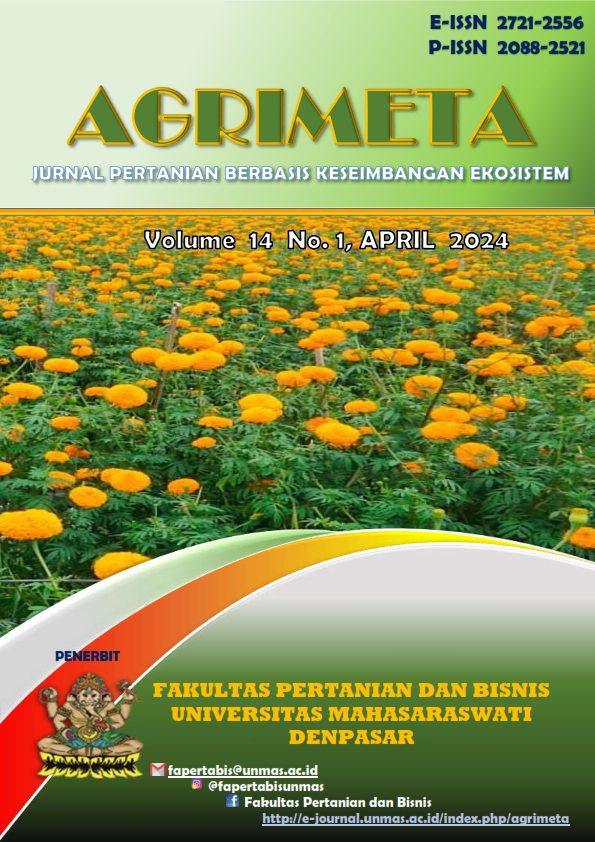UJI MUTU BENIH BUNGA MATAHARI PADA PERBEDAAN METODE PENGERINGAN DAN APLIKASI FUNGISIDA
Keywords:
sunflower seed, viability, drying methodeAbstract
This research aims to examine the viability of sunflower seeds against different drying methods and fungicide applications. This experiment consisted of two factors with a Completely Randomized Design (CRD). The first factor is the drying method, namely drying in the sun (control) with an average of 31°C for six days, cake oven and costume oven with temperatures ranging from 36.5-37.5°C for four days. The second factor is the application of fungicides, namely without fungicides and fungicides. Seed quality testing is carried out using the UKDdP method. The experiment consisted of 6 treatment combinations which were repeated three times so that there were 18 experimental units. Each experimental unit used 25 seeds. The results showed that the lowest water content was 6.25% from sun drying and the highest germination rate was 73.33%. The sun drying method and the use of fungicides can produce the lowest water content, and have the highest values in the percentage of germination, vigor index, maximum growth potential, normal dry weight of sprouts, as well as the use of fungicides. It is necessary to test the temperature and drying period using a cake and custom oven to get the right time to maintain seed viability.
Downloads
References
Fauzah, S. 2014. Pengaruh pengeringan terhadap kualitas benih kedelai (Glycine max L). Jurnal Produksi Tanaman. 2 (5) : 388-394.
FAO. 2022. https://www.fao.org/faostat/en/#data/QCL
Lachabrouilli, A.-S., Rigal, K., Corbineau, F., & Bailly, C. 2021. Effects of agroclimatic conditions on sunflower seed dormancy at harvest. European Journal of Agronomy, 124, 126209. doi:10.1016/j.eja.2020.126209
Seiler, G.J., T.J. Gulya. 2016. Sunflower : overview p. 247- 253. In C. Wrigley, K. Seetharaman, H. Corke, J. Faubion (Eds.). Encyclopedia of food grains 2nd vol 1. The World of Food Grains. Elsevier, Fargo, USA. hlm 247-253. Doi: https://doi.org/10.1016/B978-0-12- 394437-5.00027-9
Tahmasebpour B, Aharizad S, Shakiba M, Bedostani AB. 2011. Safflower genotypes responses to water deficit. International Journal of AgriScience 1, 97-106.
Pradhan R. C. et al. 2009. Moisture dependent physical properties of jatropha fruit. Industrial Crops and Products, Amsterdam, v. 29, n. 2, p. 341-347.
Lima, D. de C., Dutra, A. S., Pontes, F. M., & Bezerra, F. T. C. 2014. Storage of sunflower seeds. Revista Ciência Agronômica, 45(2), 361-369.
Alit IB, Susana IGB. 2020. Pengaruh kecepatan udara pada alat pengering jagung dengan mekanisme penukar kalor. Jurnal Rekayasa Mesin. 11(1):77-84. DOI: https://doi.org/10.21776/ub.jrm.2020.011.01.9.
Asrianto A, Jamaluddin J, Kadirman K. 2018. Modifikasi mesin pengering biji-bijian dengan bahan bakar tempurung kelapa. Jurnal Pendidikan Teknologi Pertanian. 4:222-231. DOI: https://doi.org/10.26858/jptp.v4i0.7126.
Nur S, Latief MF, Yamin AA, Syamsu JA.2022. Kualitas fisik hasil pengeringan jagung sebagai bahan pakan menggunakan mesin vertical dryer. Agribios.20(2):171-178. DOI: https://doi.org/10.36841/agribios.v20i2.2280.
Haj Sghaier A, Khaeim H, Tarnawa Á, Kovács GP, Gyuricza C, Kende Z. Germination and Seedling Development Responses of Sunflower (Helianthus annuus L.) Seeds to Temperature and Different Levels of Water Availability. Agriculture. 2023; 13(3):608. https://doi.org/10.3390/agriculture13030608
Macauley Asim Ittah, Idorenyin Asukwo Udo, Ekemini Edet Obok. Sunflower (Helianthaus annuus L.) Seeds Germination in Saline Hydroculture. Journal of Plant Sciences. Vol. 7, No. 4, 2019, pp. 72-75. doi: 10.11648/j.jps.20190704.11.
Hakim MA, Suhartanto MR. 2015. Penentuan Masak Fisiologi dan Ketahanan Benih Kenikir (Cosmos caudatus Kunth) terhadap Desikasi. J. Hort. Indonesia 6(2): 84-90.






